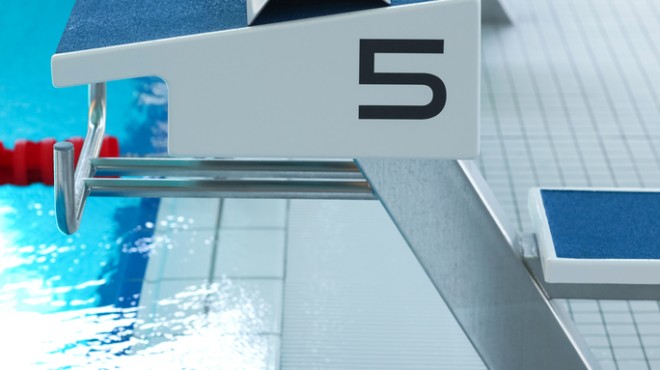Teaching Competitive Turns

Starts and turns are a vital part of any competition and often these areas are neglected during training as emphasis is placed upon attaining effective stroke technique.
Teaching competitive turns to make them efficient, as resistant as possible and controlled may come during the advanced swimmer stage, but the skills needed to correctly perform these turns can be introduced at beginner level.
Today we shall look at teaching the skills required to perform an effective front crawl tumble turn.
The skills that the learner needs are:
- Overarm front crawl
- Breath control
- Forward somersault
- Thrust from poolside
- Twist from side to forward position
- Powerful push and glide
- Dolphin leg action
Some of these skills can be introduced almost from the first lesson.
Breath control and learning when and how to exhale when the face is in the water begins during the first few weeks of learning to swim. Trickle breathing – blowing bubbles with the mouth and humming through the nose – become part of the weekly session.
Push and glide is another skill that is taught early on at the beginner stage, helping the learner to gain balance and control of their body in water. Once push and glide and breath control have been mastered, particularly humming, they can be combined into a push and glide and a somersault. This activity can be introduced at intermediate level as an ‘active rest’ following energetic kicking practices.
Learning how to push off the wall sideways and then rotate onto the front can again be practiced as a separate skill during an ‘active rest’ time. Having goggles and a focus such as the pool lane lines help with straightening the body.
Dolphin leg kick is often a fun activity that intermediate swimmers enjoy and sometimes even beginners may show an aptitude for this movement. This can be introduced in a contrast fun activity such as wriggling through a hoop.
This leaves the overarm front crawl which may be evident towards the top end of intermediate learners. The front crawl will be perfected during the swimming lessons until it is correct.
Now the other skills can be combined together to teach the front crawl tumble turn.
When teaching competitive turns it is important to know and follow the rules and regulations of the sport. The rules and regulations followed may depend on the country or county where the competition is taking place.
FINA is the international governing body of swimming, diving, water polo, synchronised swimming and open water swimming and it is these rules that are complied with , for further details go to www.fina.org.
FINA Laws for Freestyle
- SW 5.2 Some part of the swimmer must touch the wall upon completion of each length and at the finish
- SW 5.3 Some part of the swimmer must break the surface of the water throughout the race, except it shall be permissible for the swimmer to be completely submerged during the turn and for a distance of not more than 15 metres after the start and each turn. By that point, the head must have broken the surface
Approach
- Swimmer ideally should wear goggles to see the pool markings clearly – if there are any
- If no pool markings – possibly weight an object to hang from poolside into the water to indicate turning point
- Breath taken on last arm recovery
Tumble
- Head tucked in
- Recovery arm enters and cross midline to opposite hipline or both hands are pulled to side of body
- Body bends at hips, knees tuck up or legs held straight and body pikes (swimmers preference)
- Feet planted at wall side on
Push Off
- Arms straighten above head
- Eyes look forward and up along lane marking
- Vigorous drive from wall with legs
- Legs straighten
Transition into Stroke
- Glide is held until just before speed drops
- Legs begin to kick
- May be front crawl kick or butterfly kick
- One underwater arm pull to bring body to surface
- At least one arm cycle before a breath is taken
- No more than 15m under water
Combined Skills
Initially these should be taught at the deep end, 1.8 if possible, to allow for opening out during the somersault or directional problems from push off.
- Push and glide into somersault
- Swim front crawl, somersault and swim
- Swim to wall, head up, tumble and place feet on wall
- Swim to wall, head down, tumble and place feet on wall
- Swim to wall, tumble, feet on wall and push off
- Swim to wall, tumble, push off into dolphin kick
- Must surface at 15 metres or before
Faults
- Taking a breath before the tumble
- Straight legs – no drive
- Performing a full twist –out on back
- Not looking forward – too deep or off at an angle
- Recovering arm too soon
- Breathing too soon
Once the tumble turn has been mastered it should be practised regularly to improve the whole of the turn from approach to transition.
Happy teaching!
- Categories
- Swimming Teaching


